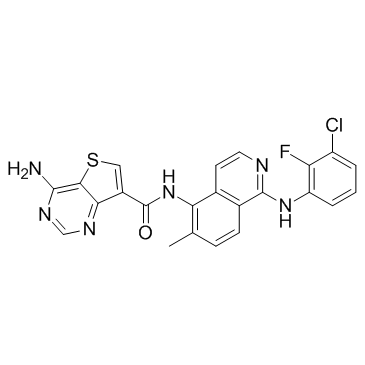| Cas No.: | 1446113-23-0 |
| Chemical Name: | 4-Amino-N-(1-(3-chloro-2-fluorophenylamino)-6-methylisoquinolin-5-yl)thieno[3,2-d]pyrimidine-7-carboxamide |
| SMILES: | O=C(C(C1=NC=N2)=CSC1=C2N)NC(C3=C4C(NC(C=CC=C5Cl)=C5F)=NC=C3)=C(C=C4)C |
| Formula: | C23H16ClFN6Os |
| M.Wt: | 478.93 |
| Sotrage: | 2 years -20°C Powder, 2 weeks 4°C in DMSO, 6 months -80°C in DMSO |
| Publication: | TW Kim et al. Belvarafenib, a novel pan-RAF inhibitor, in solid tumor patients harboring BRAF, KRAS, or NRAS mutations: Phase I study. Journal of Clinical Oncology 37, no. 15_suppl (May 20, 2019) 3000-3000. |
| Description: | Belvarafenib is a potent and pan RAF (Rapidly Accelerated Fibrosarcoma) inhibitor, with IC50s of 56 nM, 7 nM and 5 nM for B-RAF, B-RAFv600E and C-RAF respectively. |
| In Vitro: | Belvarafenib (Example 116) is a potent and pan RAF inhibitor with antineoplastic activity. The IC50 values of Belvarafenib are 56 nM, 7 nM and 5 nM for B-RAF, B-RAFv600E and C-RAF respectively. It also shows high inhibitory activity for FMS, DDR1 and DDR2 kinases, with IC50s of 10 nM, 23 nM and 44 nM, respectively[1]. |

 DC Chemicals' products qualify for U.S. tariff exemptions. We guarantee no price increases due to customs duties and maintain stable supply, continuing to deliver reliable research solutions to our American clients.
DC Chemicals' products qualify for U.S. tariff exemptions. We guarantee no price increases due to customs duties and maintain stable supply, continuing to deliver reliable research solutions to our American clients.





















